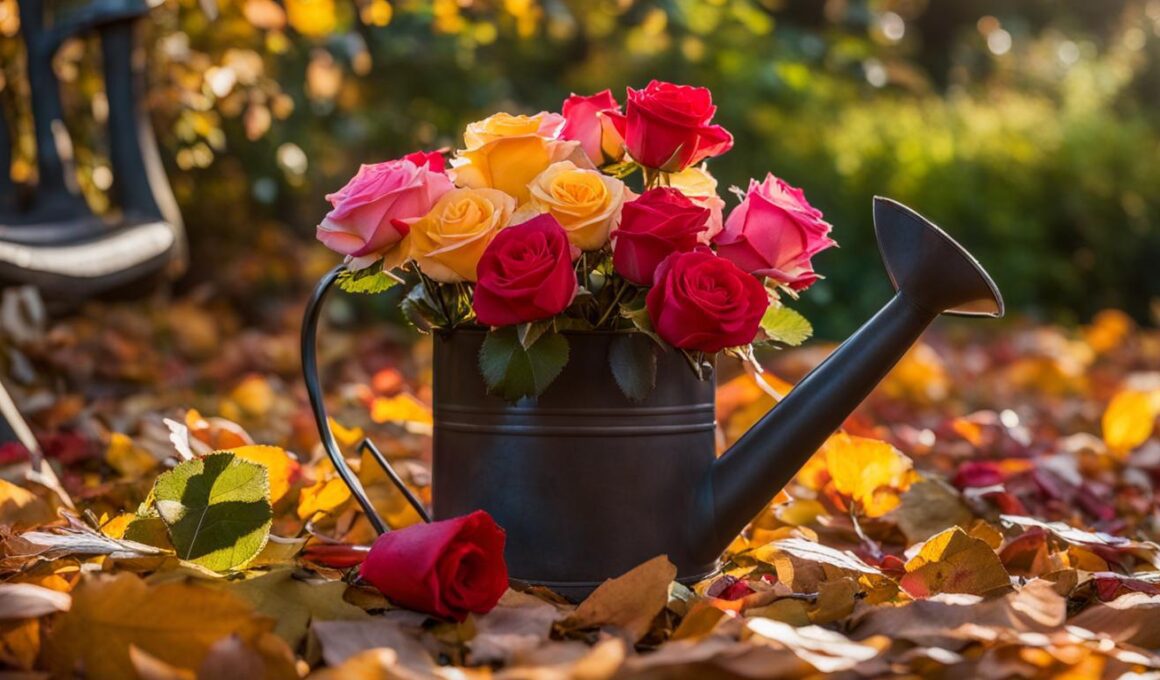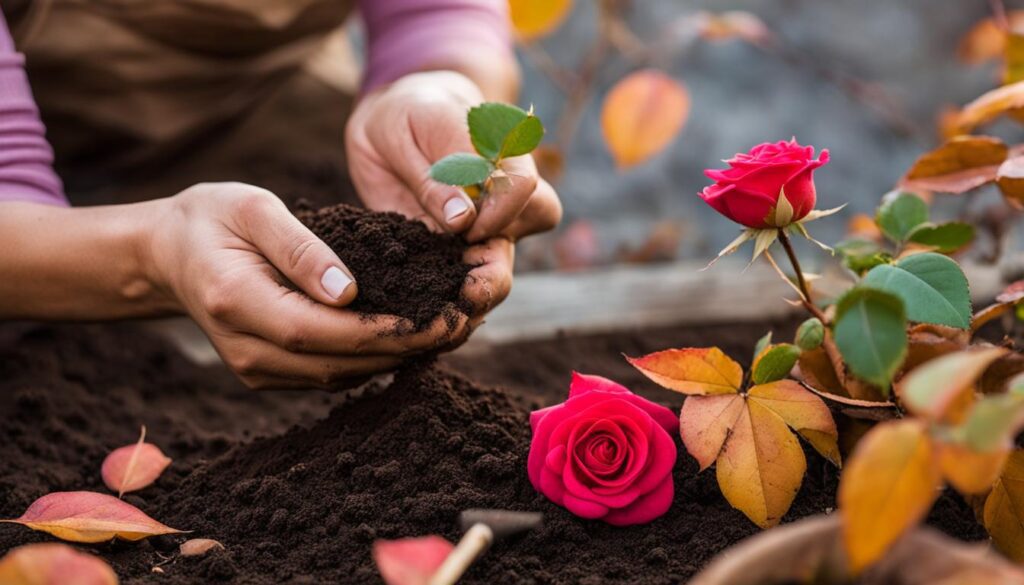Fall is the perfect time to tend to your roses and ensure a vibrant garden throughout the season. By planting and caring for roses in the fall, you can set the foundation for healthy and blooming plants in the coming spring. Whether you’re a seasoned gardener or just starting out, fall rose care is essential for maintaining the beauty of your garden.
During this time, it’s important to take proactive steps to prepare your roses for the winter months. This includes removing any fallen leaves and diseased parts to prevent the spread of fungal diseases. Pruning is also crucial to promote overall plant health and remove crossed or thin canes that can hinder growth. By mulching and providing extra protection for climbing roses, you can ensure your plants stay insulated and protected from harsh weather conditions.
But fall isn’t just about preparing your roses; it’s also an ideal time for planting new roses. With milder weather and workable soil, you can establish a strong root system before winter sets in. By following proper planting techniques and providing adequate moisture, you give your roses the best chance of thriving in the spring.
So, whether you’re looking to maintain your existing roses or introduce new ones to your garden, don’t overlook the importance of fall rose care. With a little effort now, you can enjoy a vibrant and flourishing garden in the fall and beyond.
Fall Preparation Tasks for Roses
Fall is the perfect time to prepare your roses for winter and ensure a healthy garden in the coming season. Taking care of your roses during the fall not only improves their overall health but also minimizes the risk of diseases and damage caused by harsh winter conditions. By following these fall preparation tasks, you can have beautiful and vibrant roses in your garden.
First and foremost, it is important to clean up your rose garden to prevent diseases from overwintering. Rake up and discard all the leaves that have fallen at the base of your roses. Fungal diseases can thrive on these leaves, so removing them is essential.
To further protect your roses from diseases, it’s crucial to prune them carefully. Remove any diseased leaves, stems, or branches, as they can serve as entry points for diseases. Pruning off any failed buds and addressing crossed or thin canes also promotes better overall plant health.
Applying compost or mulch around the base of your roses is another important step in fall rose care. Not only does this provide them with essential nutrients, but it also acts as insulation for the roots during the winter months. For areas that experience extremely cold temperatures, consider mounding compost around the base of the roses for extra protection.
In summary, fall preparation tasks for roses are essential for their health and vitality. By cleaning up your rose garden, pruning carefully, and providing nutrients and insulation through compost or mulch, you can ensure that your roses survive the winter and thrive in the spring. Taking these simple steps will provide you with a healthy and vibrant rose garden that you can enjoy throughout the year.
Planting Roses in the Fall
Fall is a fantastic time to start planting roses. The cooler weather and workable soil create the perfect conditions for establishing healthy plants. By planting in the fall, you can give your roses a head start and ensure fuller blooms in the spring. Here are some benefits of fall rose planting and essential care tips to establish a strong root system:
- Favorable weather and soil: Fall offers milder temperatures, which are ideal for both the roses and gardeners. The soil is still warm, making it easier to dig and work with. Take advantage of these favorable conditions to plant your roses.
- Process similar to spring planting: The process of planting roses in the fall is very similar to spring planting. Dig a hole that is large enough to accommodate the roots of the rose. Prepare the soil by loosening it and adding organic matter. Place the rose in the hole and backfill with soil, gently tamping it down to ensure good contact with the roots.
- Timing is important: It is crucial to plant at least six weeks before the first frost to allow the roses enough time to establish a strong root system. This will ensure their survival through the winter and encourage healthy growth in the spring.
- Mulch for insulation and moisture retention: Adding a layer of mulch around the base of the rose provides insulation, protecting the roots from extreme temperatures. Mulch also helps retain moisture, which is essential for root development. Apply a layer of mulch, such as wood chips or compost, around the base of the rose, taking care not to pile it up against the stem.
- Resist pruning: While pruning is an important part of rose care, it is best to resist the urge to prune back the rose in the fall. Instead, allow the plant to focus on root growth during this time. Pruning can be done in the spring to shape and rejuvenate the rose.
- Watering and fertilization: Adequate watering is essential after planting to help the rose establish its root system. Water deeply, ensuring the soil is evenly moist but not waterlogged. Occasional fertilization with a fish fertilizer can provide the necessary nutrients for a strong and healthy root system.
By following these fall planting and care tips, you can give your roses the best chance of thriving in your garden. Establishing a strong root system now will lead to beautiful blooms and a vibrant garden in the spring. Remember, fall is the perfect time to plant and care for roses, so get your gardening gloves on and enjoy the benefits of fall rose planting!
Conclusion
Caring for roses in the fall is crucial for successful rose gardening and maintaining a vibrant fall garden. By following these fall rose care tips, such as removing leaves, pruning, and applying mulch, you can protect your plants from diseases and adverse weather conditions. Proper care and attention during the autumn season will ensure that your roses thrive and bring beauty to your garden in the upcoming spring.
Fall preparation tasks, including removing diseased leaves and pruning, help maintain the overall health of your roses. By pruning off failed buds, crossed canes, and thin growth, you encourage the growth of strong canes and promote better air circulation. Adding compost or mulch around the base of your roses provides essential nutrients and insulation, while mound compost in colder zones gives them extra protection against freezing temperatures.
In addition to fall preparation, fall planting allows for the establishment of a strong root system, which is essential for healthy and vibrant blooms in the spring. Planting your roses at least six weeks before the first frost gives them ample time to develop strong roots before winter sets in. Remember to resist the urge to prune roses during fall planting, as it allows the plant to focus on root growth.
Embrace autumn’s charm by practicing proper fall rose care and planting techniques. With these fall rose care tips, you can experience the joys of a successful rose garden, full of vibrant and beautiful blooms in the upcoming spring season. So, get your gardening gloves on and start planting and caring for roses in the fall to create a flourishing garden that will bring joy and beauty year after year.
Can the same care techniques for roses in the fall be applied to growing hearts and flowers plants successfully?
When it comes to caring for roses in the fall, the same techniques may not work for growing hearts flowers. It’s essential to understand how to grow hearts flowers and provide them with the specific care they need during the autumn season. Researching and understanding the unique needs of hearts flowers is crucial for successful growth.










